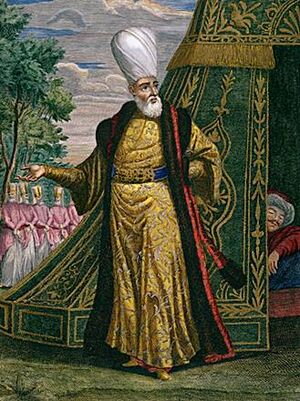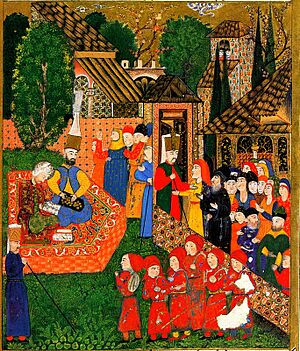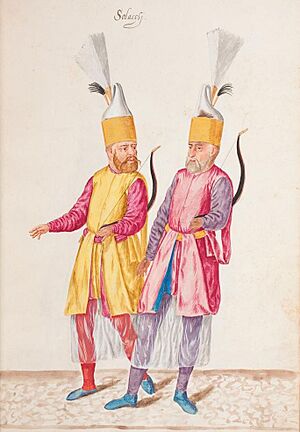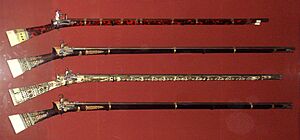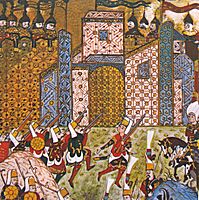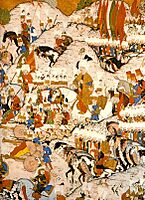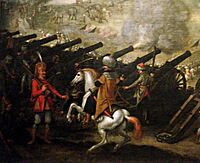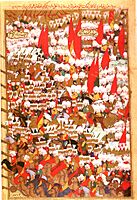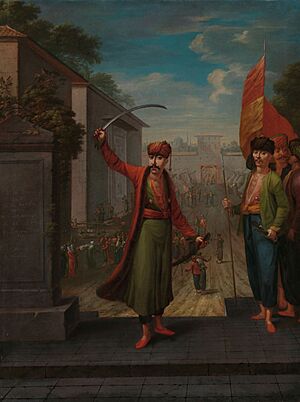Janissary facts for kids
Quick facts for kids Janissary |
|
|---|---|

Agha of the Janissaries and a Bölük of the Janissaries by Lambert Wyts, 1573
|
|
| Active | 1363–1826 (1830 for Algiers) |
| Allegiance | |
| Type | Infantry |
| Role | Standing professional military |
| Size | 1,000 (1400) 7,841 (1484) 13,599 (1574) 37,627 (1609) 135,000 (1826) |
| Part of | Ottoman army |
| Garrisons | Adrianople (Edirne) Constantinople (Istanbul) |
| Colors | Blue, Red and Green |
| Equipment | Various |
| Engagements | Battle of Kosovo, Battle of Nicopolis, Battle of Ankara, Battle of Varna, Fall of Constantinople, Battle of Chaldiran, Battle of Mohács, Siege of Vienna, Great Siege of Malta and others |
| Commanders | |
| Commander | Agha of the Janissaries |
A Janissary (pronounced yen-ih-CHAIR-ee) was a special soldier in the Ottoman Empire. These soldiers were part of the Sultan's (the ruler's) personal army. They were like an elite police force and bodyguards.
The Janissaries were one of the first modern standing armies. This means they were full-time soldiers, not just called up for wars. They were also among the first infantry (foot soldiers) in the world to use firearms.
The Janissary corps started around the 1300s. It was finally ended in 1826.
Janissaries were known for their strong teamwork and strict rules. They were paid regularly, unlike typical slaves. They were not allowed to marry or have other jobs until later in their history. This was to make sure they were completely loyal to the Sultan.
Over time, the rules changed. More people joined the Janissaries, even if they weren't trained soldiers. This made the group less focused on military skills. The Janissaries became very powerful. They sometimes even rebelled if they felt their special rights were threatened.
In 1826, Sultan Mahmud II decided to get rid of the Janissaries. This event was called the Auspicious Incident. Many Janissaries were killed or exiled.
Contents
How the Janissaries Started
The Janissary army began during the rule of Sultan Murad I (1362–1389). The Ottoman Empire took a share of all war captives. From these captives, the Sultan created the Janissary corps. This army was loyal only to him.
From the late 1300s to 1648, Janissaries were recruited through a system called devşirme. This system involved taking non-Muslim boys, mostly from Christian families in the Balkans. These boys were then converted to Islam. They were trained to become soldiers in the Ottoman army. Boys from places like Albania, Bosnia, Greece, and Bulgaria were often chosen.
The Janissaries were called kapıkulları, which means "slaves of the Porte." But they were not like regular slaves. They were paid salaries and received pensions when they retired. They became a powerful social class in the Ottoman Empire. The smartest Janissaries could even go to the Enderun School. This was a special palace school.
Most Janissaries came from non-Muslim backgrounds. This was because it was not allowed to enslave a Muslim. These boys were usually between 10 and 20 years old. They were taken from their families and sent to Turkish families. There, they learned Turkish and Muslim customs. After this, their military training began. They had strict rules, like not being allowed to grow beards or marry. This made them very disciplined soldiers. They were part of the askeri class, which was the military class.
Later, in the late 1500s, a Sultan allowed Janissary children to join the corps. This had been forbidden for 300 years. They were also allowed to grow beards. These changes made the Janissaries even more powerful. However, it also made the army less disciplined.
Some Christian families were willing to let their sons join the devşirme system. This was because it offered a chance for a better life. Conscripts could become high-ranking officers or even governors.
Famous Janissaries included George Kastrioti Skanderbeg. He was an Albanian lord who later led a revolt against the Ottomans. Another was Sokollu Mehmed Paşa, a Bosnian Serb who became a very powerful Grand Vizier. He was like the Sultan's chief minister.
Life as a Janissary
The Janissary corps was special in many ways. They had unique uniforms and were paid regular salaries. They marched to music played by their own military band, called the mehter. They lived in barracks and were the first to use firearms widely.
A Janissary battalion was like a close family. The Sultan himself would sometimes visit their barracks. He would even dress like a Janissary soldier and receive his pay with them. In peacetime, Janissaries also worked as police, palace guards, and firefighters.
They had excellent support during military campaigns. Other groups helped prepare roads, set up tents, and bake bread. Their weapons and supplies were brought by the cebeci corps. They even had their own medical teams. Sick and wounded soldiers were taken to mobile hospitals behind the lines.
These unique features made the Janissaries famous. They were seen as a symbol of the Ottoman Empire. Over time, many Janissaries took on other jobs. They gained the right to marry and enroll their children in the corps. Many became administrators or scholars. Retired Janissaries received pensions.
Training and Status
The first Janissaries were war prisoners and slaves. Later, the Ottoman government used the devşirme system to get recruits. Boys were taken at a young age and trained to be loyal to the Sultan. Joining the Janissaries often improved a boy's social status. In poor areas, parents sometimes even bribed officials to take their sons. This gave their children a better chance in life.
At first, recruiters preferred boys from Greece and Albania. As the Ottoman Empire grew, the devşirme included boys from Armenia, Bulgaria, Croatia, Hungary, Serbia, and later Bosnia. Sometimes, boys from Romania, Georgia, Circassia, and Ukraine were also taken.
This "child levy" system was used regularly in the 1400s and 1500s. Some historians believe it helped spread Islam in non-Muslim areas.
After the 1570s, the Ottoman government needed more soldiers. The Janissary corps grew quickly. Training times became shorter. The average age of recruits increased. This was because musketeers needed less training than archers. Also, the rule that only devşirme boys could join was lifted. Free-born Muslims could now join, including the sons of current soldiers. By the mid-1600s, the devşirme system was mostly abandoned.
Janissaries were taught to see the corps as their home and family. They saw the Sultan as their father. Only the strongest recruits became true Janissaries around age 24 or 25. The corps inherited the property of dead Janissaries, which made them wealthy.
Janissaries followed the teachings of the dervish saint Haji Bektash Veli. This was like having a chaplain for the soldiers. They wore special hats called "börk." These hats had a small holder for a spoon. This symbolized their "brotherhood of the spoon," showing their strong bond as they ate, slept, and fought together.
Training Details

When a non-Muslim boy was recruited, he first lived with Turkish families. There, he learned Turkish, Islam, and Ottoman customs. After this, new recruits, called acemi oğlan, went to a school in the capital city. Here, young cadets were trained in different skills. Some became engineers, others riflemen, archers, or artillery experts.
Janissaries trained under strict rules. They lived in simple, almost monastic, conditions. Unlike other Muslims, they were not allowed to grow beards, only mustaches. These rules were followed until the 1700s. That's when Janissaries started to take on other jobs and break some of the old rules.
Even with the corps growing, Janissaries continued to train hard. They tried new battle tactics. In 1605, they were one of the first armies in Europe to use rotating lines of volley fire. This meant soldiers would fire in turns, keeping up a constant attack.
How the Janissaries Were Organized
The Janissary corps was divided into units called ortas. An orta was like a battalion and was led by a çorbaci. All the ortas together formed the Janissary corps, known as the ocak. Sultan Suleiman the Magnificent had 165 ortas. This number grew to 196 over time.
The Sultan was the supreme commander. But the Janissary corps was led by a commander called the ağa. The corps had three main parts:
- The cemaat: These were frontier troops, with 101 ortas.
- The bölük or beylik: These were the Sultan's personal bodyguards, with 61 ortas.
- The sekban or seymen: These had 34 ortas.
There were also 34 ortas of ajemi (cadets). A separate Janissary corps was based in Algiers.
Originally, Janissaries could only be promoted based on how long they had served. They could only leave their unit to command another. Only their own officers could punish them. Their rank names were often based on kitchen staff or royal hunters.
Janissary Numbers
The Janissaries were part of the royal army and the Sultan's guards. But they were not the largest part of the Ottoman military. In the early days, Janissaries made up only about one-tenth of the army. The main force was the traditional Turkish cavalry.
In the 1300s, there were about 1,000 Janissaries. By 1475, there were about 6,000. The provincial cavalry, called the Timarli Sipahi, numbered around 40,000.
Starting in the 1530s, the Janissary corps grew a lot. This was because the Ottomans were conquering many new lands. Janissaries were important for guarding forts and for sieges. Sieges became very important for the Ottoman military. The corps grew even faster after the 1570s due to wars with the Safavid Empire and the Habsburg monarchy.
By 1609, the corps had about 40,000 men. It grew even more later in the century, especially during the Cretan War (1645–1669) and the Great Turkish War.
| Year | 1400 | 1484 | 1523 | 1530 | 1547 | 1574 | 1582 | 1592 | 1609 | 1654 | 1666–67 | 1687–88 | 1699 | 1710–71 |
|---|---|---|---|---|---|---|---|---|---|---|---|---|---|---|
| Strength | <1,000 | 7,841 | 7,164 | 8,407 | 12,131 | 13,599 | 16,905 | 23,232 | 37,627 | 51,047 | 47,233 | 62,826 | 67,729 | 43,562 |
Janissary Weapons and Gear
When they first started, Janissaries were skilled archers. But they quickly began using firearms in the 1440s. During the siege of Vienna in 1529, their engineers and miners were famous. In close combat, they used axes and kilijs (a type of sword).
In peacetime, they could only carry clubs or daggers, unless they were border guards. The Turkish yatagan sword was a special weapon for Janissaries. It was almost a symbol of their group. Janissaries who guarded the palace carried long-handled axes and halberds.
By the early 1500s, Janissaries were skilled with muskets. They used a large "trench gun" that fired an 80 mm ball. This gun was feared by their enemies. Janissaries also used early grenades and hand cannons. Pistols became popular later, after the Cretan War (1645–1669).
Janissaries in Battle
The Ottoman Empire used Janissaries in all its major wars. This included the capture of Constantinople in 1453. They also fought against the Mamluk Sultanate of Cairo and in wars against Hungary and Austria.
Janissary troops were always led into battle by the Sultan himself. They always shared in the loot (treasures taken from defeated enemies). The Janissary corps was the only infantry (foot soldier) division of the Ottoman army.
In battle, their main job was to protect the Sultan. They used cannons and smaller firearms. They held the center of the army against enemy attacks. The Janissary corps also had special teams. These included explosive experts, engineers, sharpshooters, and sappers. Sappers were soldiers who dug tunnels under fortresses.
-
Janissaries battling the Knights Hospitaller during the Siege of Rhodes in 1522.
-
Battle of Mohács, 1526.
Revolts and Their End

As Janissaries became more aware of their power, they wanted more. By the early 1600s, they had so much influence that they controlled the government. They could rebel, tell the Sultan what to do, and stop efforts to modernize the army. They even changed Sultans through palace coups.
They also became landowners and businessmen. They allowed only the sons of former Janissaries to join. These new recruits didn't have to go through the strict training. This lowered the army's military value. When Janissaries could demand money from the Sultan, their fighting skills decreased. The Ottoman Empire's northern borders began to shrink after the second Battle of Vienna in 1683.
In 1449, the Janissaries revolted for the first time. They demanded higher wages, and they got them. This set a pattern for their future behavior. In 1566, Sultan Selim II allowed Janissaries to marry. This weakened their loyalty to the Sultan's family.
By 1622, the Janissaries were a "serious threat" to the Empire. They were greedy and undisciplined. They were no longer effective against modern European armies. In 1622, the young Sultan Osman II tried to stop their bad behavior. He wanted to disband the Janissary corps. But the Janissaries revolted. They captured the Sultan and murdered him.

In 1730, Janissaries led by Patrona Halil supported a rebellion in Istanbul. This led to Sultan Ahmed III giving up his throne. The rebellion was crushed, but it showed the Janissaries' power.
In 1807, another Janissary revolt removed Sultan Selim III. He had tried to modernize the army. His supporters failed to get him back on the throne. But they helped Mahmud II become Sultan in 1808. When the Janissaries threatened Mahmud II, he had his captured rival executed. He then made a deal with the Janissaries.
Sultan Mahmud II knew the Janissaries were a threat. He secretly worked to strengthen his position. The Janissaries' abuse of power and their high cost had become too much. Many of the 135,000 men were not even active soldiers.
By 1826, the Sultan was ready to act. He told them he was forming a new, modern army. As he expected, they rebelled. They marched on the Sultan's palace. In the fight, the Janissaries' barracks were set on fire by artillery. About 4,000 Janissaries died. The survivors were either sent away or executed. Their belongings were taken by the Sultan. This event is known as the Auspicious Incident. The last Janissaries were killed in a place called the Tower of Blood.
After the Janissaries were disbanded, Mahmud II created a new army. It was called the Mansure Army. By 1830, this army had grown to 27,000 troops. It included cavalry (soldiers on horseback). This new military corps lasted until the end of the Ottoman Empire.
Janissary Music
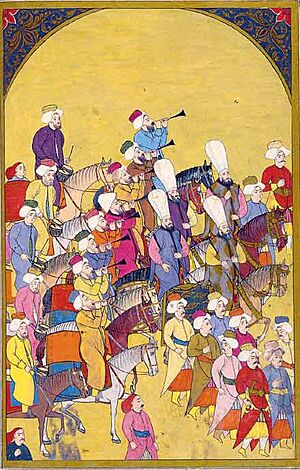
The Janissaries had unique military music. It was known for its powerful drums and loud wind instruments. They used giant drums (kös), bass drums (davul), loud shawms (zurna), trumpets (boru), bells (çevgan), triangles, and cymbals (zil).
Janissary music influenced famous European composers. These included Wolfgang Amadeus Mozart and Ludwig van Beethoven. They both wrote music in the "Turkish style." For example, Mozart's Piano Sonata No. 11 and parts of Beethoven's Symphony No. 9.
Sultan Mahmud II ended the mehter band in 1826. He replaced it with a European-style military band. Today, the Janissary corps no longer exists. But the tradition of Mehter music continues as a cultural attraction.
In 1952, the Janissary military band, Mehterân, was brought back. They perform during national holidays and historical events.
|
See also
- Devşirme system
- Mamluk
- Military of the Ottoman Empire
- The Auspicious Incident
- Agha, a civilian and military title in the Ottoman Empire


